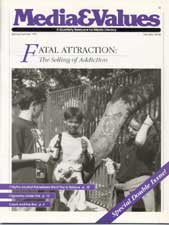Alcohol in Prime Time: 10 Guidelines for Writers
|
This article originally appeared in Issue# 54-55
|
The following set of guidelines for the entertainment community about the use of alcohol in TV entertainment shows has helped to raise the consciousness of producers and writers for over a decade. Use it in your own viewing at home, or in a class or group to evaluate the depiction of alcohol use in the programs you watch. Check to see that shows don't:
- Glamorize the drinking or serving of alcohol as a sophisticated or adult pursuit;
- Show the use of alcohol gratuitously-in those cases where another beverage might easily and fittingly be substituted;
- Omit the grim consequences of alcohol misuse or alcoholism;
- Deny characters a chance to refuse an alcoholic drink by statements such as "What will you have?:" or "Do you want a drink with the rest of the guys?"
- Show drinking as an activity that is so normal everyone must indulge; allow for decision making by the character;
- Show excessive drinking without consequences or with only pleasant consequences;
- Show miraculous recoveries from alcoholism; normally, it is a difficult task;
- Show children "lusting after" alcohol and the time when they are adult enough to drink it;
- Associate drinking alcohol with macho pursuits in such a way that heavy drinking is a requirement for proving oneself as a man;
- Omit the reaction of others to heavy alcoholic drinking especially when it may be a criticism.
From Target: Prime Time. Advocacy Groups and the Struggle Over Entertainment Television.



